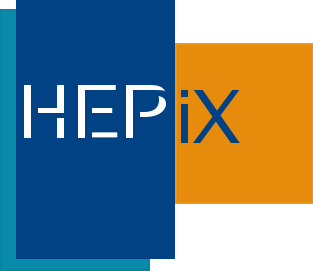Martin Lothar Purschke
(Brookhaven National Laboratory (US))
12/10/2015, 14:00
Grid, Cloud & Virtualisation
We report on a simulation effort using the Open Science Grid which
utilized a large fraction of the available OSG resources for about 13
weeks in the first half of 2015.
sPHENIX is a proposed upgrade of the PHENIX experiment at the
Relativistic Heavy Ion Collider. We have collected large data sets of
proton-proton collision data in 2012 and 2013, and plan to carry out a
similar study...
Michel Jouvin
(Laboratoire de l'Accelerateur Lineaire (FR))
14/10/2015, 08:50
Grid, Cloud & Virtualisation
This presentation is a general introduction, and it will also describe the opportunities for cooperation with HEPIX and how sites can participate in GDB.
Arne Wiebalck
(CERN)
14/10/2015, 09:00
Grid, Cloud & Virtualisation
This presentation will provide an update of the activities in the CERN Cloud service since the Oxford workshop.
Arne Wiebalck
(CERN)
14/10/2015, 09:20
Grid, Cloud & Virtualisation
This talk will summarise our activities related to the optimisation of the virtualised compute resources in our OpenStack-based infrastructure. In particular, we will discuss some of the issues we've encountered and the various optimisations we've applied to bring the virtual resources as close as possible to bare-metal performance.
Sean Crosby
(University of Melbourne (AU))
14/10/2015, 09:40
Grid, Cloud & Virtualisation
In the CERN Cloud Computing project, there is a need to ensure that the overall performance of hypervisors and virtual machines does not decrease due to configuration changes, or just because of the passage of time.
This talk will outline an automated performance framework currently being developed, which will allow performance of virtual machines and hypervisors to be graphed and linked.
Christopher Hollowell
(Brookhaven National Laboratory)
14/10/2015, 10:00
Grid, Cloud & Virtualisation
Application containers have become a competitive alternative to virtualized servers.
Containers allow applications to be written once, distributed across a heterogeneous
environment (ie, cloud, remote data centers) and executed transparently on multiple platforms
without the performance overhead commonly found on virtual systems. We present an initial
evaluation of Docker, along with a...
Domenico Giordano
(CERN)
14/10/2015, 10:50
Grid, Cloud & Virtualisation
Performance measurements and monitoring are essential for the efficient use of computing resources as they allow selecting and validating the most effective resources for a given processing workflow. In a commercial cloud environment an exhaustive resource profiling has additional benefits due to the intrinsic variability of a virtualised environment. In this context resource profiling via...
Wataru Takase
(KEK)
14/10/2015, 11:10
Grid, Cloud & Virtualisation
Cloud computing enables a flexible provisioning of computing resources by utilizing virtual machines on demand, and can provide an elastic data analysis environment. At KEK we plan to integrate cloud-computing technology into our batch cluster system in order to provide heterogeneous clusters dynamically, to support various kinds of data analyses, and to enable elastic resource allocation...
Chander Sehgal
(Fermilab)
14/10/2015, 11:30
Grid, Cloud & Virtualisation
The Open Science Grid (OSG) ties together computing resources from a broad set of research communities, connecting their resources to create a large, robust computing grid; this computing infrastructure started with large HEP experiments such as ATLAS, CDF, CMS, and Dzero and it has evolved so now it is also enabling the scientific computation of many non-physics researchers. OSG has been...
Andrea Chierici
(INFN-CNAF)
14/10/2015, 11:50
Grid, Cloud & Virtualisation
INDIGO-DataCloud aims at developing a data and computing platform targeted at
scientific communities, integrating existing standards and open software
solutions. INDIGO proposes:
- to build-up a PaaS solution leveraging existing resources and e-Infrastructures, since the mere access to IaaS resources has been demonstrated as not being a realistic option for most Research Communities
-...
Andrew David Lahiff
(STFC - Rutherford Appleton Lab. (GB))
14/10/2015, 12:10
Grid, Cloud & Virtualisation
Running services in containers managed by a scheduler offers a number of potential benefits compared to traditional infrastructure, such as increased resource utilisation through multi-tenancy, the ability to have elastic services, and improved site availability due to self-healing. At the RAL Tier-1 we have been investigating migration of services to an Apache Mesos cluster running on bare...
Brian Lin
(University of Wisconsin - Madison)
14/10/2015, 14:00
Grid, Cloud & Virtualisation
HTCondor-CE is a special configuration of HTCondor designed to connect compute resources to the wider grid. Leveraging the power of HTCondor, HTCondor-CE is able to provide built-in security measures, end-to-end job tracking, and better integration with overlay job systems. This talk will present an overview of the HTCondor-CE software, its deployment in the Open Science Grid (OSG), and...
James Botts
(LBNL)
14/10/2015, 14:20
Grid, Cloud & Virtualisation
This presentation will describe work that has been done to
make NERSC Cray systems friendlier to data intensive workflows
in anticipation of the availability of the NERSC-8 system this Autumn. Using shifter, a docker-like container technology developed at NERSC by
Doug Jacobsen and Shane Canon, the process of delivering
software stacks to Cray compute nodes has been greatly...
Dr
Qiulan Huang
(Institute of High Energy of Physics Chinese Academy of Science)
14/10/2015, 14:40
Grid, Cloud & Virtualisation
The report will introduce our plan of computing resources virtualization. We will discuss progress of this project such as Openstack-based infrastructure, virtual scheduling and measure. And we will share experience of our test-bed which deployed with Openstack icehouse.
